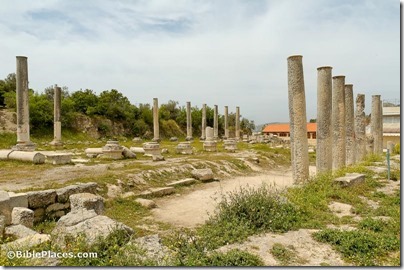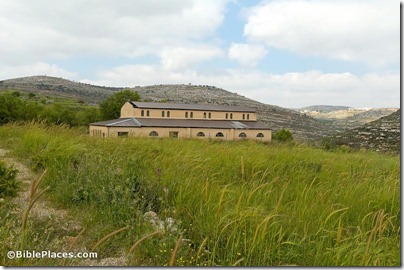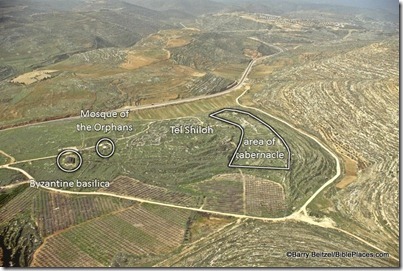The eleventh season at Khirbet el-Maqatir has concluded with word of a spectacular find that cannot yet be revealed. The team excavated several Roman-period silos, a first-century ritual bath, and an Iron Age house. The season at Tel Burna is coming along nicely. The First Week Wrap-up provides an overview of the known stratigraphic sequence of the site. The report for days 6-7 include a photo of a large monolith and a beautiful Iron IIB pavement. John Black shows how archaeological work in Jerusalem has undermined historical criticism of the Gospel of John. A Picasso drawing is being raffled to raise money to preserve the archaeological remains of Tyre. The Egyptian Museum in Cairo was recently closed to tourists by striking employees. Leon Mauldin illustrates Jeremiah’s message of the cursed man who will be like a “shrub in the desert.” He follows that up with a photo of a “land of salt.” Barry Britnell shows with photos why the Cilician Gates are important for Paul’s journeys. Douglas Petrovich provides a summary of his recent article that serves as a “John the Baptist” role for his forthcoming book, Evidence of Israelites in Egypt from Joseph’s Time until the Exodus. 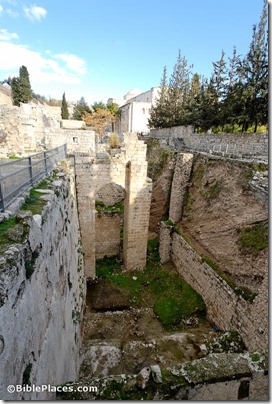 Southern pool of Bethesda
Southern pool of Bethesda
Photo from the Pictorial Library of Bible Lands
One of the most important sites from biblical times is neglected and deteriorating today. Samaria, the third and most significant capital of the kingdom of Israel, is prey to looters and vandals, as reported in yesterday in an article by the Associated Press.
“Sebastia, the archaeological site, is abandoned without any control from 2000. It’s 13 years,” said Osama Hamdan, a Palestinian architect who has coordinated the restoration works of Crusader-era buildings with [Carla] Benelli. “A lot of destruction of cultural heritage in this area has happened.”
He said statues, vases, coins and glasses have all been taken by looters.
Weeds grow freely among the archaeological ruins, sticking out from the ancient stones. Plastic bottles and food bags are littered at the bottom of the staircase that leads to a Crusader cathedral – also site of a mosque – where the tomb of John the Baptist is said to be located in the village of Sebastia. Finely decorated stone Roman tombs in the center of the village are smashed and abandoned.
At a Byzantine church dedicated to John the Baptist, located in the Israeli-controlled part, graffiti hailing the Hamas militant group is spray-painted on a column. The Islamic expression of faith – “There is no god but God” – is written in Arabic over the entrance.
The full article is here.
HT: Charles Savelle
Photo from Samaria and the Center
Plans to reconstruct Herod’s tomb at the Herodium have been scrapped.
The same article reports that the Herod exhibition at the Israel Museum has been extended to January 2014.
Tuesday’s Samaritan Passover ceremony is described in a Haaretz article. (I believe the first photo caption is wrong, for the animal is not slain until sunset.)
105 million euros is not enough to save Pompeii from deterioration, according to a New York Times video.
Ferrell Jenkins is back in Israel and he recently spent a morning with Shmuel Browns.
The Spring 2013 season at Tel Burna is over and they have found evidence of a destruction in the 9th century. There are still a few days left to sign up for the summer season.
Haaretz’s “Tourist Tip #218” describes the significance of the Broad Wall of Jerusalem.
The temporary bridge to the Mughrabi Gate next to the Western Wall still stands, but next month a committee is going to meet in Paris to discuss its replacement.
FoxNews reports on apps for archaeology.
Berlin’s Pergamon Museum has a new exhibition on the Mesopotamian city of Uruk. Better photos are available here.
Christianbook.com is now selling The New Interpreter’s Dictionary of the Bible (5 vols.) for only $99.99. (That’s 75% the $400 list.)
A rare, original set of the 13 volumes of the Survey of Western Palestine has just been listed by a UK bookseller for $6,400. For $35 more, you can pick up a digital copy of the oversized maps.
HT: Jack Sasson
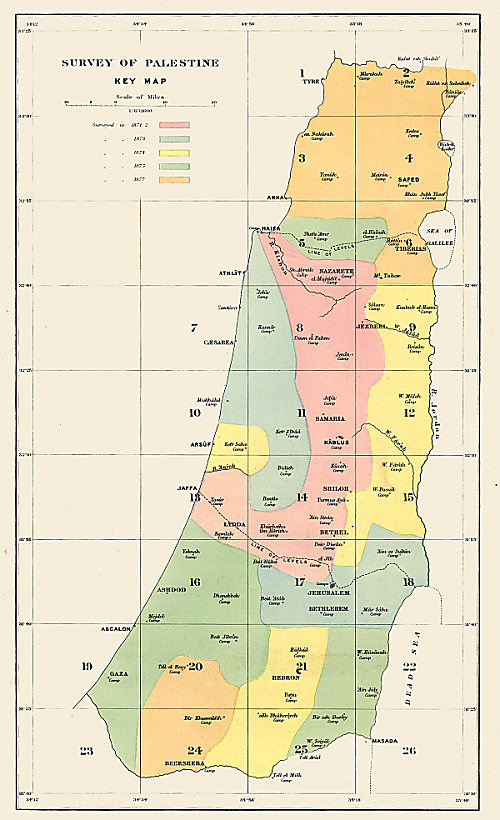
- Tagged Excavations, Holidays, Italy, Jerusalem, Judah, Mesopotamia, Museums, Resources, Samaria, Shephelah, Weekend Roundup
A report of the discovery of an ancient church building at Shiloh struck me as questionable. Because several churches have been discovered at Shiloh in the past (including one in 2006), I wondered if this was a recycled report. You can read the story as reported by Israel HaYom, YourJewishNews, and Algemeiner.
Yisrael Medad, a resident of modern Shiloh, clarifies that the discovery is simply more of the Byzantine basilica excavated by the Danish expedition in the 1920s. The new excavations revealed a destruction layer which may be dated to the time of the Samaritan Revolt in AD 529. Medad’s blog has photos of the new excavations.
- Tagged Discoveries, Samaria
Arutz-7 reports on the theft of a vessel from Shiloh discovered a week ago.
An ancient vase that provided evidence that Shilo was sacked by Philistines has been stolen from the Shilo site. Avital Sela, who manages the site, told Arutz Sheva that once the vase was discovered to have been stolen, a complaint was filed with police. Sela explained that the vase, which was dated precisely to the year in which the destruction of Shilo was assumed to have taken place, "connected all of the Biblical pieces into one puzzle."
The full story is here.
- Tagged Excavations, Samaria
Arutz-7 is reporting today on the excavation of biblical Shiloh.
A new archeological find at ancient Shilo fits in with the Biblical narrative regarding the war at Even Ha’ezer [Ebenezer], and could confirm scholars’ conjectures as to how Shilo was destroyed.
The First Book of Samuel does not say when and how Shilo, which served as the Israelite capital for 369 years, was destroyed. The latest archeological find at the Shilo site – a broken vase and remains of ashes from a fire – indicate large scale destruction. The remains are from the same period in which the War of Even Ha’ezer [Ebenezer] against the Philistines was waged.
Israel suffered a crushing defeat in that war, which is believed to have been waged near present-day Afek. The two sons of Eli the High Priest were killed, and Eli himself died upon hearing the news. Worst of all, the Holy Ark, which the Israelites had brought to the battleground, was taken by the Philistines.
Archeologists and scholars now have more evidence to back the assumption that after defeating the Israelites at Even Ha’ezer [Ebenezer], the Philistines advanced upon Shilo and sacked it.
Other Biblical passages, in Psalms and Jeremiah, confirm that Shilo was destroyed by Phlistines [sic].
A few comments:
1. The minimalistic reporting makes it impossible to evaluate the claim. The discovery of a broken vase and remains of ashes could indicate nothing more than the presence of a family hearth. Perhaps the archaeologists did find a destruction layer, but you have to believe that the journalist has evidence he was unwilling to share.
2. A destruction layer from the time of Samuel was already identified in Israel Finkelstein’s excavations in the 1980s. “This complex of buildings [in Area C] was destroyed by a violent conflagration whose traces were visible everywhere: charred floors and heaps of fallen bricks, sometimes more than one meter deep….As suggested by Albright following the Danish expedition’s excavations, this may be attributable to the Philistine destruction of the site (mid-eleventh century BCE)” (NEAEH 4: 1368).
3. The theory that the Philistines destroyed Shiloh in the aftermath of their capture of the ark at Aphek seems to be supported by the absence of Shiloh in the biblical narrative in the years of Samuel, Saul, and David. Its destruction by Philistines is suggested by its mention in two passages.
Psalm 78:60 — “He abandoned the tabernacle of Shiloh, the tent he had set up among men.”
Jeremiah 7:12–14 — “‘Go now to the place in Shiloh where I first made a dwelling for my Name, and see what I did to it because of the wickedness of my people Israel. While you were doing all these things, declares the Lord, I spoke to you again and again, but you did not listen; I called you, but you did not answer. Therefore, what I did to Shiloh I will now do to the house that bears my Name, the temple you trust in, the place I gave to you and your fathers.”
The Arutz-7 story, with a photo of a jar, is here.
- Tagged Analysis, Discoveries, Samaria
The BiblePlaces Blog provides updates and analysis of the latest in biblical archaeology, history, and geography. Unless otherwise noted, the posts are written by Todd Bolen, PhD, Professor of Biblical Studies at The Master’s University.
As an Amazon Associate we earn from qualifying purchases. In any case, we will provide honest advice.
